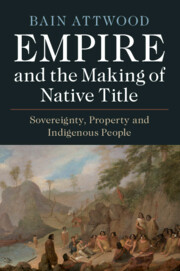Book contents
- Empire and the Making of Native Title
- Empire and the Making of Native Title
- Copyright page
- Dedication
- Contents
- Acknowledgements
- Abbreviations
- Principal Players
- Maps
- Introduction
- 1 Claiming Possession in New Holland and New Zealand, 1770s–1820s
- 2 Batman’s Treaty and the Rise and Fall of Native Title, 1835–1836
- 3 The South Australian Colonisation Commission, the Colonial Office and Aboriginal Rights in Land, 1834–1837
- 4 Protection Claims and Sovereignty in the Islands of New Zealand, 1800–1839
- 5 Making Agreements and a Struggle for Authority, 1839–1840
- 6 The Land Claims Commission and the Return of the Treaty, 1840–1843
- 7 A Colony in Crisis and a Select Committee, 1843–1844
- 8 The Retreat of the Government and the Rise of the Treaty, 1844–1845
- 9 The Making of Native Title, 1845–1850
- Conclusion
- Appendix: The English Text of the Treaty of Waitangi
- Bibliography
- Index
7 - A Colony in Crisis and a Select Committee, 1843–1844
Published online by Cambridge University Press: 03 July 2020
- Empire and the Making of Native Title
- Empire and the Making of Native Title
- Copyright page
- Dedication
- Contents
- Acknowledgements
- Abbreviations
- Principal Players
- Maps
- Introduction
- 1 Claiming Possession in New Holland and New Zealand, 1770s–1820s
- 2 Batman’s Treaty and the Rise and Fall of Native Title, 1835–1836
- 3 The South Australian Colonisation Commission, the Colonial Office and Aboriginal Rights in Land, 1834–1837
- 4 Protection Claims and Sovereignty in the Islands of New Zealand, 1800–1839
- 5 Making Agreements and a Struggle for Authority, 1839–1840
- 6 The Land Claims Commission and the Return of the Treaty, 1840–1843
- 7 A Colony in Crisis and a Select Committee, 1843–1844
- 8 The Retreat of the Government and the Rise of the Treaty, 1844–1845
- 9 The Making of Native Title, 1845–1850
- Conclusion
- Appendix: The English Text of the Treaty of Waitangi
- Bibliography
- Index
Summary
Hobson’s successor as Governor, Robert FitzRoy found New Zealand in crisis but had few resources to address it and adopted rash measures that appeared to abandon the means by which the British government hoped to acquire ownership of vast swathes of land. A major political struggle erupted in London between the New Zealand Company and the Colonial Office with the former spinning a powerful tale that its troubles were primarily the result of the natives’ rights of property in land being defined wrongly. More specifically, the Company’s directors and Lord Howick blamed the Treaty of Waitangi for the way that the natives’ rights in land had been defined. It mattered not a jot that the stories told about its significance involved more fiction than fact. For its part, the Colonial Office insisted that the Treaty had to be upheld in light of what had happened in the past, the facts on the ground in New Zealand and the undertakings the Crown had given the natives. In the colony, abstract legal principles and philosophical ideas similarly played little role in the way the key British players approached native title, especially in comparison to a mixture of moral, political and strategic considerations.
- Type
- Chapter
- Information
- Empire and the Making of Native TitleSovereignty, Property and Indigenous People, pp. 243 - 300Publisher: Cambridge University PressPrint publication year: 2020



